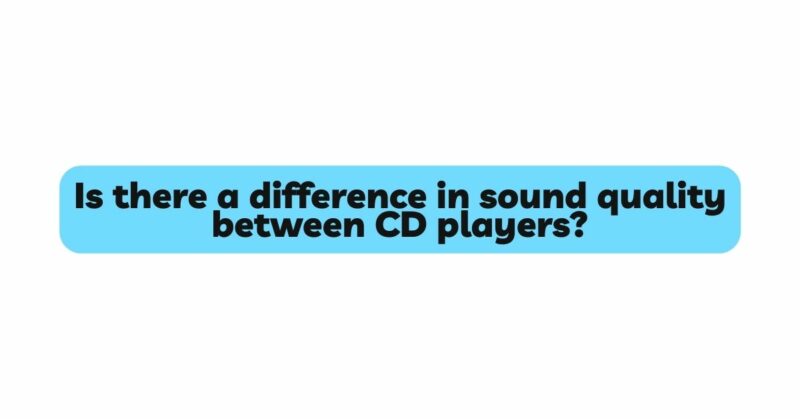In the realm of audio playback, the quest for the ultimate sound quality is a pursuit that has captured the imagination of audiophiles and music enthusiasts for decades. One particular facet of this pursuit revolves around CD players, the stalwarts of digital audio reproduction. With a wide array of CD players available on the market, a pertinent question emerges: Is there a discernible difference in sound quality between these players? This article delves into the intricacies of sound quality in CD players, examining factors that contribute to sonic variations and exploring the extent to which these differences can be perceived.
The Sonic Signature of CD Players: CD players, while all adhering to the same fundamental principle of converting digital information from a disc into analog sound waves, can exhibit variations in their sonic characteristics. These differences can stem from various factors, including the quality of components, design philosophies, and engineering choices made during the manufacturing process. The sonic signature of a CD player encompasses tonal balance, soundstage, imaging, transient response, and other sonic attributes that collectively define the auditory experience.
Components and Circuitry: The components and circuitry within a CD player play a pivotal role in shaping its sound quality. From the digital-to-analog converter (DAC) to the power supply, each component has the potential to introduce subtle nuances or alterations to the audio signal. Higher-end CD players often incorporate premium DACs, clock systems, and analog output stages that contribute to improved accuracy, reduced noise, and enhanced sonic fidelity. Conversely, budget-oriented players may rely on more cost-effective components that could potentially impact audio quality.
DAC Technology: The heart of any CD player lies in its DAC, responsible for converting the digital data on the disc into analog audio signals. DAC technology has evolved significantly over the years, with advancements leading to improved precision, lower distortion, and better noise rejection. Multi-bit Delta-Sigma DACs, for instance, are known for their ability to provide accurate conversion, while ladder DACs offer a different sonic character. The choice of DAC technology can influence the overall sound signature of a CD player.
Transport Mechanism and Error Correction: The transport mechanism, responsible for reading data from the CD, and the error correction system both impact sound quality. High-quality transports ensure accurate data retrieval, minimizing read errors and reducing the potential for jitter—a timing discrepancy that can negatively affect sound quality. Error correction algorithms, present in all CD players, vary in effectiveness. Robust error correction mechanisms can mitigate the impact of disc imperfections on sound quality.
Jitter and Timing Accuracy: Jitter, a common concern in digital audio, refers to timing inaccuracies in the transmission of data. It can arise during data extraction from the disc, data transmission within the player’s components, or during the conversion process. Excessive jitter can lead to smearing of audio details and reduced clarity. Advanced CD players employ techniques such as clock regeneration, reclocking, and asynchronous communication to minimize jitter and enhance timing accuracy.
Analog Output Stage: The analog output stage, responsible for converting the analog signal from the DAC into a form suitable for amplification, also influences sound quality. Components such as op-amps, capacitors, and output transformers contribute to tonal characteristics, dynamics, and overall transparency. High-quality components in the analog stage contribute to a cleaner, more faithful reproduction of the audio signal.
Listening Tests and Subjective Perception: The quest for sound quality differences among CD players often involves subjective listening tests. Audiophiles and enthusiasts engage in A/B comparisons, where they listen to the same music passage through different CD players and evaluate perceived differences. While individual perceptions vary, trained listeners can often discern subtle nuances in tonal balance, imaging, and transient response. However, the perceptibility of these differences depends on factors such as the listener’s hearing acuity, the quality of associated equipment, and the listening environment.
Room for Skepticism: As with any pursuit involving subjective perception, skepticism is warranted. Human auditory memory is transient and subject to cognitive biases, which can influence perceived differences. Double-blind tests, where neither the listener nor the operator knows which CD player is being used, help mitigate biases and offer a more objective evaluation of sound quality differences.
Conclusion: The question of whether discernible sound quality differences exist between CD players is a multifaceted inquiry that encompasses engineering, design philosophy, and individual auditory perception. While advancements in technology have allowed for greater precision and fidelity in CD player design, the extent to which these differences are perceived depends on various factors. Audiophiles seeking the ultimate listening experience may appreciate the nuanced sonic signatures of different CD players, each contributing a unique character to the music. As technology continues to advance, the realm of audio playback remains an enthralling exploration of perception and fidelity.

